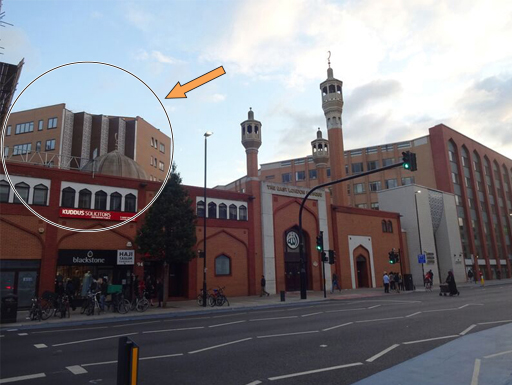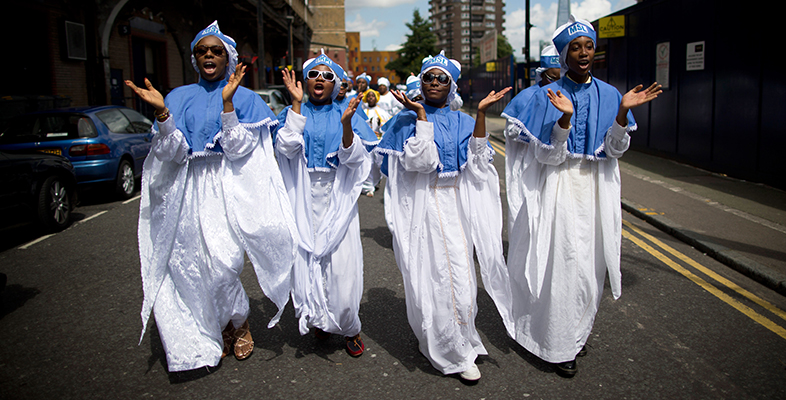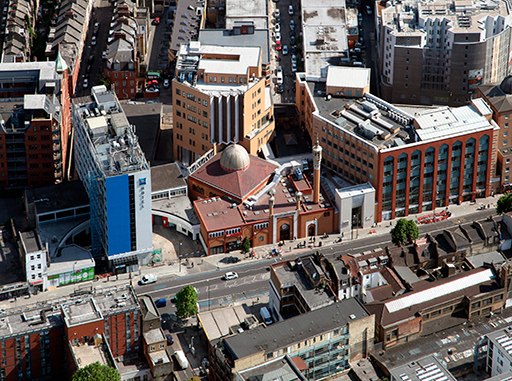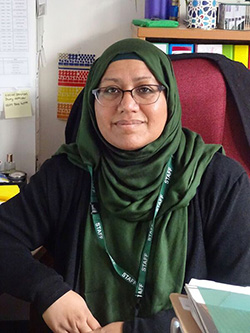3.1 The East London Mosque
To start this process, we will return to a specific place, but this time to consider how it is used by those who go there.
Here we are going to look at the East London Mosque on Whitechapel Road. London’s Muslim population originated from the Muslim seamen who arrived in the nineteenth century. Often they were paid off from their ships and obliged to seek accommodation until they could find new employment or passage home. Sometimes they ended up remaining in London.
Since then, there have been several other waves of Muslim immigration to Britain. In London, many immigrants settled in the East End and the first provisions for communal Muslim worship were in converted residential spaces in the area. Today’s purpose-built mosque was completed in 1985.
Mosques are primarily a place where Muslim communities can gather for prayer. However, mosques are also used for a wide variety of religious instruction and other communal activities. As scholar Sophia Gilliat-Ray explains, mosques:
Exist at the heart of the community and all the obligations associated with the five ‘pillars’ of Islam involve mosques in one way or another. … Mosques are spaces for discussion and debate, for the settlement of disputes, for the performance of rites of passage, for education and for social welfare.
The East London Mosque has sought to expand its ability to serve a variety of functions for its community. It added a building to host more community services, the London Muslim Centre, in 2004. It completed building the Maryam Centre, making specific provision for women, in 2013.
The London Muslim Centre and the Maryam Centre

The London Muslim Centre hosts a large range of community services, including education for children in supplementary schools and education in Islam and Arabic for all members of the community. There are also a number of culturally specific charities hosted by the Centre. These include the Somali Development Association (Al Shafie Institute) and the North African Community Association (NACA). The Centre offers pro bono legal advice for members of the community. It also includes a library and archives documenting its history and activities.
Historically, Muslim women’s use of mosques has been significantly different from that of men (Katz, 2014, p. 7). Women are not required to attend collective prayers in mosques on Friday. There are also regulations regarding modesty, dress codes and the avoidance of sexual temptation by separating the genders, particularly during prayer time.
Although the primary purpose of the Maryam Centre was to provide prayer facilities for women, it has come to hold a much broader role.
Activity 8
Take a moment to reflect upon your assumptions on the separation of women and men in religious contexts.
Now, listen to this interview with Sufia Alam the manager of the Maryam Centre at the East London Mosque, who will explain how the Maryam Centre is used. As you listen, reflect on if your assumptions about women’s spaces – does Sufia Alam say anything that surprises you?
Transcript
Discussion
The Maryam Centre may be primarily a prayer space, but it also offers a variety of other services. It offers a women’s only gymnasium and exercise area, educational facilities specifically reserved for women and free counselling with professional female therapists. Although not mentioned in this short interview, Sufia Alam also works closely with the local council on issues of child welfare and domestic violence. She is able to make interventions within the community by communicating with the women in what is perceived by the community to be a safe space. The Maryam Centre allows the women of the community space to network and make decisions about their needs without involving the men of the community.


